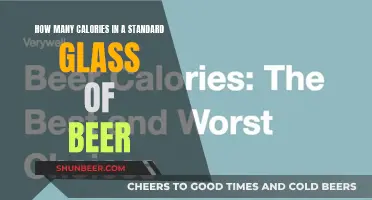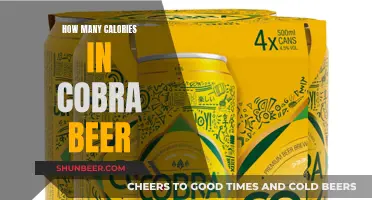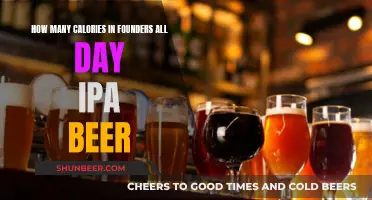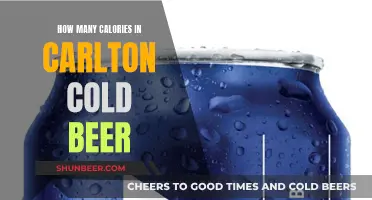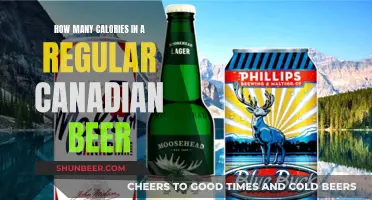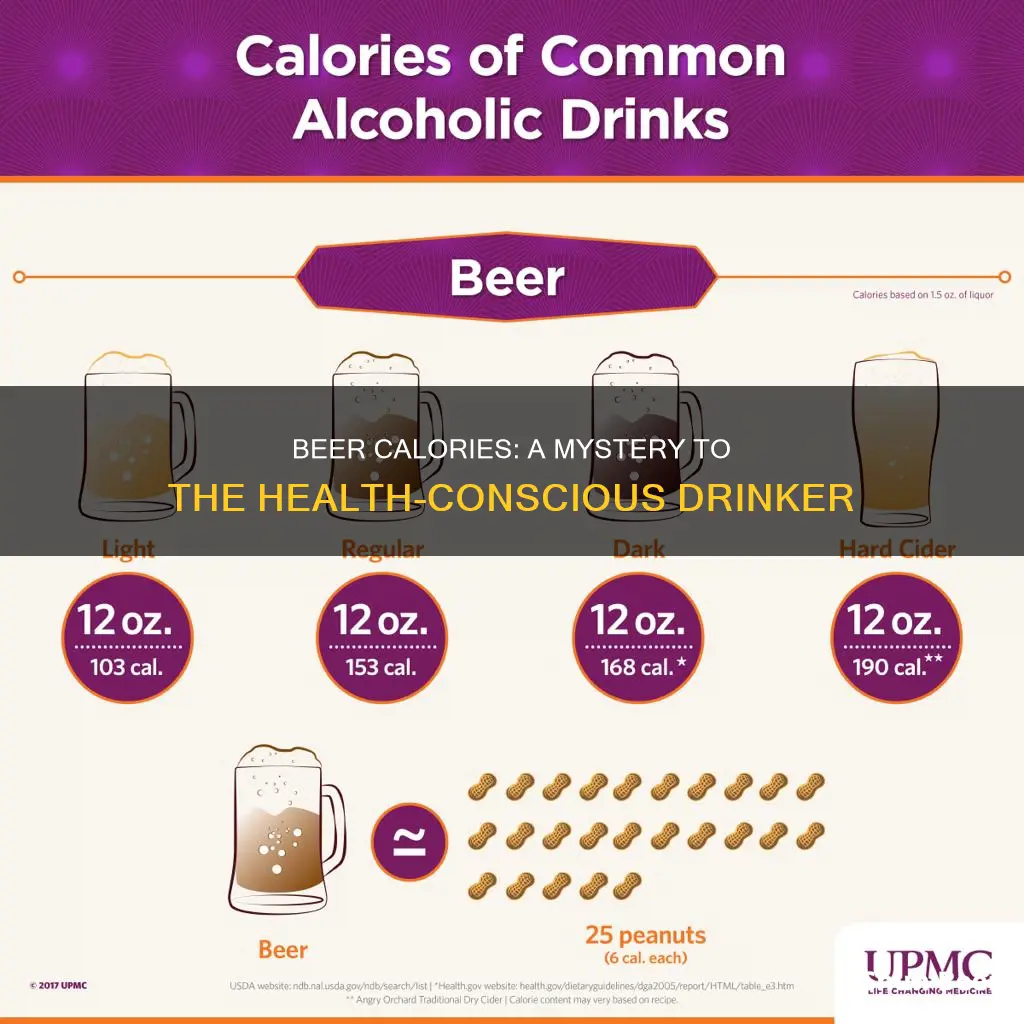
Alcoholic drinks, including beer, are not required to display calories or nutritional information on their packaging. This is because, since the end of prohibition, alcohol has been regulated by the Alcohol and Tobacco Tax and Trade Bureau (TTB) rather than the Food and Drug Administration (FDA). The TTB has never required nutrition labels, and while there have been attempts to change this, alcohol manufacturers have generally opposed them. Beer calories primarily come from alcohol and carbohydrates, with alcohol contributing around 60% and carbohydrates contributing 40%. A higher alcohol content will result in more calories, and a light beer will usually have fewer calories.
What You'll Learn
- Alcoholic drinks are regulated by the Alcohol and Tobacco Tax and Trade Bureau (TTB), not the Food and Drug Administration (FDA)
- TTB has never required nutrition labels
- Manufacturers are concerned that displaying calories will reduce consumption and hurt profits
- Alcohol is high in calories, with 7 calories per gram
- Beer is also high in carbohydrates, which contribute to calorie count

Alcoholic drinks are regulated by the Alcohol and Tobacco Tax and Trade Bureau (TTB), not the Food and Drug Administration (FDA)
Alcoholic drinks, including beer, are not required to display calorie information on their packaging. This is because, since the end of prohibition, they have been regulated by the Alcohol and Tobacco Tax and Trade Bureau (TTB), not the Food and Drug Administration (FDA). The TTB has never required nutrition labels on alcoholic products, unlike the FDA, which has stringent rules about labelling for all food products.
The TTB was originally created to generate tax revenue on the newly legalised beverages. Alcoholic drinks are therefore treated differently from food and other beverages when it comes to labelling requirements. While there have been attempts to change this, with some consumer and health groups lobbying for nutrition labels, these have been largely opposed by the alcohol industry.
In 2013, the TTB did make labels optional for manufacturers, but not mandatory. This has led to some alcohol brands using nutrition as a marketing tool, but without a consistent means of comparison between products. For example, beer commercials might tout the absence of high-fructose corn syrup or the presence of low carbs, without providing full nutritional information.
Alcoholic drinks do have to list some information on their labels. Substances that may cause sensitivities, such as sulfites and synthetic dyes, must be listed, and distilled spirits and wines with 7% alcohol or higher must include an alcohol percentage. However, there is no requirement to list ingredients or provide nutritional information.
The absence of nutritional information on alcoholic drinks can make it difficult for consumers to make informed choices about their purchases. Alcohol contains seven calories per gram, which is second only to fat at nine calories per gram, and much higher than protein or carbohydrates, which have four calories per gram. As a result, alcoholic drinks can contribute a significant number of calories to a person's diet.
Michelob Ultra Beer: Calorie Count and Nutrition Facts
You may want to see also

TTB has never required nutrition labels
The Alcohol and Tobacco Tax and Trade Bureau (TTB) has historically been the regulatory body for alcoholic beverages in the United States. Since the end of prohibition, the TTB has been responsible for overseeing alcohol-related matters, including the labelling of alcoholic products.
Unlike the Food and Drug Administration (FDA), which requires nutrition labels on food products, the TTB has never mandated similar disclosures for alcoholic drinks. This distinction in regulatory treatment has resulted in a lack of transparency around the nutritional content of alcoholic beverages, including beer.
The TTB's stance on nutrition labelling has been a topic of debate, with some advocating for increased transparency and others expressing opposition. In 1993, the TTB sought public feedback on whether their regulations should be amended to mandate nutrition facts on alcohol labels. However, the response was underwhelming, with only 55 comments submitted, most of which opposed the idea.
In 2004, the TTB issued guidelines that allowed manufacturers to voluntarily disclose calories, carbs, protein, and fat content, but this remained optional. This voluntary approach continues to be the case, as the TTB has not implemented mandatory nutrition labelling for alcoholic beverages. The absence of mandatory nutrition labels on beer and other alcoholic drinks can be attributed to the TTB's historical position on this matter.
Calories in Beer: Understanding the Breakdown of Your CBC Pint
You may want to see also

Manufacturers are concerned that displaying calories will reduce consumption and hurt profits
Alcoholic beverages, including beer, are regulated by the Alcohol and Tobacco Tax and Trade Bureau (TTB) rather than the Food and Drug Administration (FDA). Since the end of prohibition, the TTB has never required nutrition labels on alcoholic beverages.
In 2013, the TTB made labels optional, but not mandatory, for manufacturers. This led some alcohol brands to use nutrition as a marketing strategy, without any consistent means of comparison between products. For instance, beer commercials might tout the absence of high-fructose corn syrup or the presence of low carbs.
However, in 2016, some of the largest beer manufacturers shifted their stance. Anheuser-Busch, MillerCoors, HeinekenUSA, Constellation Brands Beer Division, North American Breweries, and Craft Brew Alliance, which collectively produce more than 80% of the beer sold in the US, announced that they would include a small serving facts statement on their labels by the end of 2020.
Craft Beer Calories: Which Brews Pack the Most Punch?
You may want to see also

Alcohol is high in calories, with 7 calories per gram
Alcoholic beverages, like many other drinks, contain calories that can add up quickly. A night out for a couple of drinks can add 500 calories or more to your daily intake. Alcohol is high in calories, with seven calories per gram, second only to fat at nine calories per gram, and much higher than protein or carbohydrates, which have four calories each.
The calories in beer mainly come from carbohydrates and alcohol. About 60% of calories in beer come from alcohol, and 40% come from carbohydrates. Beer with a higher alcohol content will have more calories than a beer with lower alcohol content. For example, a 12-ounce beer that is 4% ABV has about 150 calories, while an IPA with a high alcohol content can have more than 300 calories in 12 ounces.
Beer tends to be higher in calories than other beverages, including wine and spirits (e.g. vodka, rum, tequila). A standard glass of wine can contain up to 158 calories, and some pints of stronger lager can contain up to 222 calories. A pint of your average IPA contains 250 calories, while a glass of red wine holds 125, and a shot of whiskey has about 100.
Since alcoholic drinks are high in calories, they can contribute to weight gain and obesity. Watching how much you drink can help you lose weight or maintain a healthy weight. If you are trying to lose weight, it is important to think about what you are drinking as well as what you are eating.
Calories in Summer Shandy Beer: How Much?
You may want to see also

Beer is also high in carbohydrates, which contribute to calorie count
Beer is a popular drink worldwide, but it is often associated with empty calories and weight gain. So, why is that the case? Well, it turns out that beer is also high in carbohydrates, which contribute to its calorie count.
Beer is produced through the fermentation of cereal grains, which are rich in carbohydrates. This process breaks down the carbohydrates into simpler sugars, which are then converted into alcohol. However, not all carbohydrates are broken down, and some remain in the final beer product. The amount of carbohydrates in beer can vary depending on the type of beer and the brewing process. Regular lagers typically contain 10 to 15 grams of carbohydrates per pint, while some 'light' beers may have less than 10 grams or even less than 5 grams per pint. Stouts, Porters, and Guinness tend to be on the higher end of the spectrum, with upwards of 20 grams of carbohydrates per pint.
The carbohydrates in beer are mostly in the form of simple sugars, which are easily digestible and provide a quick source of energy. However, when consumed in excess, these sugars can lead to weight gain. Additionally, the alcohol in beer also contributes to its calorie content, with about 60% of the calories in beer coming from alcohol and 40% from carbohydrates. A higher alcohol content will result in more calories in the beer.
It is important to note that not all beers are created equal when it comes to carbohydrate and calorie content. "Light" beers, for example, tend to have lower carbohydrate and calorie content. These beers usually have lower alcohol content and more water, resulting in fewer overall calories. Additionally, different brands of beer may have varying carbohydrate counts, so it is always a good idea to check the nutrition label or look up the nutritional information online.
While beer may be high in carbohydrates and calories, it is important to remember that it can still be enjoyed in moderation as part of a balanced diet. Additionally, non-alcoholic beers tend to have lower calorie counts and can be a healthier alternative. Furthermore, contrary to popular belief, beer also contains significant levels of vitamins, antioxidants, minerals, and fiber, which can provide some health benefits.
Calories in an IPA: What's the Count?
You may want to see also
Frequently asked questions
Beer is regulated by the Alcohol and Tobacco Tax and Trade Bureau (TTB), not the Food and Drug Administration (FDA), so it's not required to have a nutrition facts label.
The main reason for the separation of food products and alcohol was to generate tax revenue on the newly legalized beverages.
Yes, in 1993 and 2003 there were attempts to require nutrition labels on alcoholic beverages. In 2004, the TTB issued guidelines that allowed manufacturers to list calories, carbs, protein, and fat if they wanted to. In 2013, the TTB made labels optional.
Excess calorie consumption can come from many things, and one area of our diets that is sometimes overlooked is alcohol. Nutrition labeling may help people become more aware of serving sizes and how alcohol can add to daily calorie intake. On the other hand, creating a Nutrition Facts label is an expensive and time-consuming process, and it would raise production costs for small-scale manufacturers, winemakers, and brewers.


